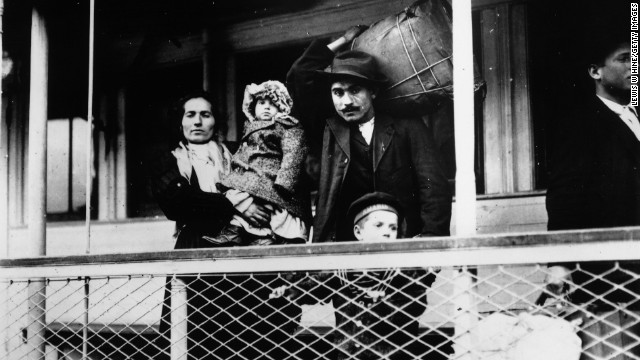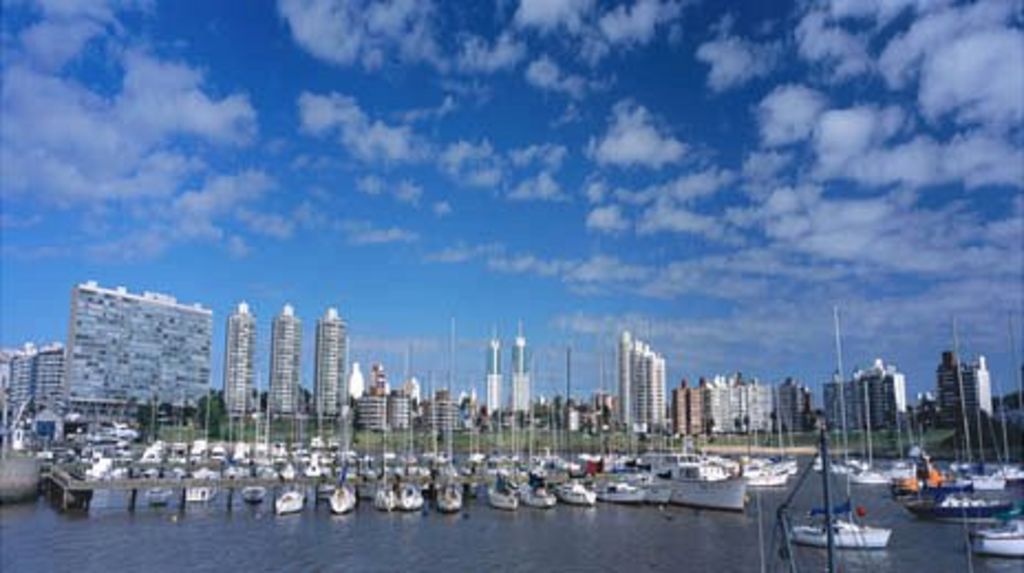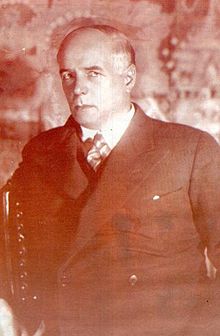Italian Immigration and Uruguay
By Sean Dowd

Italian Immigrants
The history of Uruguay has a very important connection with Italian immigrants. The period from 1830 to the First World War was a period of high migration from European countries. Emigration from Europe has affected South America as a whole, and some countries have been influenced by immigrants more than others. For Uruguay, there has not been a group of immigrants more important than the Italians. In 1908, with 861,464 Uruguayans and 181,202 foreigners in Montevideo, the Italians were 62,337 of them (Patat, 65). With this amount of foreigners in the country, and during the early years of the state, it is obvious that Italians have influenced many things in the nation, such as politics, economics, culture, and the history of Uruguay. Even today, the diaspora from Italy continues to have a profound impact on this country.
Politics
South America during the early nineteenth century was a violent time. There were many civil wars and wars, and there were no clear borders between the countries. At this point the future of Uruguay was not sure, and its neighboring countries wanted its territory. During the early period of the 19th century, Argentina tried to conquer Uruguay (Longman, 351). In the meantime, Garibaldi who had been exiled from Italy for his revolutionary ideas, and he went to Uruguay. He liked Montevideo because it was a city with other people with liberal ideas, and because so many Europeans were exiled from Europe for having political ideas considered dangerous. When Argentina attacked Uruguay, he helped Uruguay as a military commander. 4,000 Italians from Montevideo joined the army under him. Garibaldi commanded an army and even a fleet, through the war with Argentina and the civil war (Longman, 354). This separated Uruguay from other countries in South America because it was more democratic than the others, where there were pseudo-military dictatorships. Even after the country’s formation, the Italians continued to play a role in Uruguay’s politics.

Statue of Garibaldi in Montevideo
“Politically, apart from the temporary attraction of anarchism among both Spanish and Italian members of the nascent working class, the two groups took divergent paths in their political incorporation into Uruguay. Ever since Garibaldi and his Italian legion had fought on the side of the colorados against the blancos in the civil war of 1839–51 (la guerra grande), Italians preferred that political group. From early on, the colorados were therefore dubbed the ‘party of the foreigners’. The blancos, or National Party, on the other hand, advocated the preferential treatment of natives, even though the Spanish, and in particular the descendants of the more rurally based Basques, formed a strong contingent in their ranks “(Goebel, 207)
It was common in South America to have a deep political division between the countryside and the cities. Here, Montevideo was the place where immigrants lived, and unlike Argentina or Brazil, the scarcity of land in Uruguay meant that there were fewer opportunities for immigrants to settle in the countryside and devote themselves to agriculture (Goebel , 208.). This contributed to the fact that Italians created good systems to assimilate other Italian immigrants, and the country’s infrastructure was based on these systems. The political environment in Uruguay has helped to create a government with many social services, such as public education for all (Goebel, 205-215)
Italians in Uruguay also brought their ideas from Italy, “But Italian political influence went much further because, at the end of 19 th century and the beginning of 20 th , thousands of Italians who had been politically active in their own country in labor unions and as anarchist militants, arrived and made a big impact on Uruguayan politics and the labor movement. As a direct consequence, Uruguay was the first country in Latin America to legally establish the eight hour working day and to accept labor unions. ” (Arocena.) The Italians created these communities and conditions that make Uruguay’s environment good for other immigrants. Trade unions and workers’ rights were Italian ideas, and they were the first steps for social services. In addition, these innovations started the social services policy, which was very early for South America at that time, to this day Uruguay still has good social services, “From the perspective of educational level, Uruguay stood out for having been the first country in the region to eradicate illiteracy and to achieve significant progress in school attendance rates among children and youth. Until the 1960s, the Uruguayan university held great prestige in the region and attracted students from the rest of Latin America. “(Pellegrino, 15). Things like education, hunger, healthcare have advanced in Uruguay.

A Marina in Montevideo
Industry
The Italians also influenced the industry of Uruguay during this period. Because the majority lived in Montevideo, immigrants in fact dominated the industry in the city during this period, “Nel 1889 gli uruguayani costituivano 53,16 per cento della popolazione di Montevideo, ma controllavano solamente il 14,02 per cento degli stabilimenti industriali e il 20,97 dei capitali investiti; gli stranieri, che costituivano il 46,84 per cento degli abitanti di Montevideo, controllavano l’85,98 per cento delle industrie e il 79,03 dei loro capitali.” ( Italian emigration, 175). It was not only that the Italians in Uruguay had influence on the industry, but the connection with Italy was also important. “Mentre nel 1877 le esportazioni dell’Uruguay in Italia non rappresentavano nessuna quota percentuale del commercio di esportazione, nel 1905 esse ne raccoglievano il 3%> e così ai prodotti della repubblica si è aperto un nuovo mercato. Le im- portazioni dall’Italia sono poi aumentate dal 5,15% all’ 8,48% del movimento “(Anzilotti, 152). The data show that the connection between Italy and Uruguay has helped the growth of Uruguay’s industry. This shows that the diaspora has helped the global economy for the country of origin. For Uruguay and Italy, these diaspora connections are important for their economies.
 Gabriel Terra, President of Uruguay 1931-1938
Gabriel Terra, President of Uruguay 1931-1938
After the First World War
After this period, the quantity of immigrants has decreased. The president, Gabriel Terra, created anti-immigration laws (Cohens, 241). Terra was a politician with fascist ideas, so he created laws against Jews and communists coming from Europe (Santiago, 432). There was a movement against immigration in the government, and the country had gone in a more conservative direction under Gabriel Terra. Uruguay prior to this passed other laws such as these laws, against non-European immigration, which made immigration from Africa, the Middle East, and Asia more difficult. At this point, there has also been an anti-Semitic sentiment in the government, but Jews came to Uruguay anyway. Despite the laws, Jews had to flee Europe during that time, and 10,000 went to Uruguay to find security (Cohens, 241). But at this point, immigration to true South America has started to slow down.
/arc-anglerfish-arc2-prod-mco.s3.amazonaws.com/public/DNXCNEXKQRFLZFGQO257CYDNYI.jpg)
Mussolini And Hitler 
Rincon Del Bonete
But the Italians and the government of Uruguay still had a connection with Italy during the period of Fascism. Gabriel Terra and Hitler and Mussolini had been allies in world politics. Uruguay was at that time an example of Italian culture and authoritarianism in South America, at least Mussolini and Uruguay’s politicians thought so. And the fascists have tried to extend into South America through Uruguay. Gabriel Terra received money from Hitler and Mussolini to build the largest dam in South America, “En el 1935, habiendo creado un estado autoritario, Terra mostró su cercanía a las ideas filo-fascistas rompiendo relaciones diplomáticas con la URSS y con la República Española y estableciendo estrechos vínculos con la Italia de Mussolini y la Alemania de Hitler, de quien obtuvo recursos para la construcción de la represa del Rincón del Bonete “(Carusi, 179). So Terra made an alliance with Mussolini, and considered Uruguay an “Italian” country. Fascist governments wanted to use Uruguay as a strong point to spread Fascism on the continent, specifically Italian fascism, and the Italian identity, “Con este fin, desde junio a agosto de 1937, Federzoni viajaba en Sudamérica; las memorias de este viaje14 fueron enviadas a Mussolini el 30 de octubre de 193715 y contienen en ellas significativas reflexiones del presidente del Senado acerca de la estrategia para expandir la influencia fascista en América Latina. Federzoni mostraba un particular optimismo en relación a Uruguay, país que consideraba ya profundamente fascista e imaginaba una estrategia per transformar el pequeño Estado rioplatense en un verdadero representante de la Italia fascista en América Latina. ” (Carusi, 180). But with the fall of fascism in Europe, Uruguay was no longer a strong point of fascism in South America, although there was a period of military dictatorship Gabriel Terra, fascism was not as strong.
The culture
Italian immigrants also influenced the culture of Uruguay: art, law, science, food, theater, everything is different thanks to Italy. The theater has used many Italian traditions, and stories, and in fact many authors in Uruguay have written directly in Italian (Zannier, 54). Furthermore, the law of Uruguay has taken so much from Italy, and many thoughts of the law have used ideas from Italy, “Quasi tutti i cultori di diritto uruguaiani risentono, in differente misura, l’influenza di questi pensatori i cui trattati costituiscono sempre per essi lettura obbligatoria ” (Zannier, 56-57). The science of Uruguay also took a lot from Italy, because its foundation was helped by Italian scientists (Zannier, 59). Also the food, “And of course local gastronomy was also influenced: we have the traditional pizza, and also faina (made of chick-pea flour) and polenta (hot or fried cornmeal cooked in the Italian style)” (Arocena). The culture of Uruguay at every level has something from Italy, from food to the lexicon of Uruguayan Spanish.
 Faina of Uruguay
Faina of Uruguay
Uruguay of Today
After the Second World War, the quantity of immigrants has generally decreased. In fact, during the second half of the century, more people emigrated from Uruguay than came to the country, “Like Argentina and southern Brazil, Uruguay has historically been an important receptor of European immigrant waves. But during the second half of the 20th century it turned into a net exporter of its population. Though the dominant phenomenon from Independence until the mid-20th century was immigration, various testimonies have indicated a movement of population, beginning early on, towards Argentina and Brazil. ” (Pellegrino, 14) So the country has transformed itself from an importer to an exporter of people. Like Italy, Uruguay started a diaspora with in its country. The majority of immigrants to Uruguay recently are Uruguayan, returning from abroad with education and talents from other countries (Montevideo portal). As always, Uruguay is a good environment for immigrants who are educated and capable. Uruguay offers positions and services to immigrants, so the country is a good place for them. The emigration and immigration of Uruguay is like the diaspora of Italy where immigrants create global connections. Immigrants can return to their countries of origin with talents and money from other countries, and create a “network”. For example, there are organizations for this reason to find and connect immigrants abroad, “A very recent and original contribution is the Italian Patronatos, which are institutions funded directly from Italy geared to reestablishing contact with Italian migrants around the world. A director of one of these institutions explained why this initiative is taking place:
There is now a new Italian offensive -to give it a name- in relation to their Diaspora. Now that Italy has solved its own economic problems, the authorities want to regain contact with their overseas communities. In Uruguay there are 7,000 Italians who were born in Italy but 100,000 Italians who were born in Uruguay.
These Uruguayan-born Italians are the children of immigrants, and they have been applying on a massive scale to obtain Italian passports and nationality because this gives them the chance to migrate to Europe and, under European Union regulations, they are allowed to work not only in Italy but in other European countries too. Things have come full circle. “(Arocena). Therefore, the connection between Italy and Uruguay is still strong today thanks to immigrants.

Conclusion
The Italian diaspora has changed Uruguay. Immigrants brought Italy’s culture and ideas to Uruguay. From Garibaldi who helped with the formation of the country, to the immigrants who created the communities that have become the foundation for today’s social systems, every historical period in the country has a piece from Italy. It is like the country, Uruguay has its own diaspora, which creates connections in the world, and helps its development.
Works Citated
- Patat, Alejandro. Vida Nueva; La lingua italiana in America Latina. biemmegraf, 2012.
- Longman, Addison W. Garibaldi in Uruguay: A Reputation Reconsidered. University oxford press.
- Goebel, Michael. GAUCHOS, GRINGOS AND GALLEGOS: THE ASSIMILATION OF ITALIAN AND SPANISH IMMIGRANTS IN THE MAKING OF MODERN URUGUAY 1880–1930. University oxford press.
- Zannier, Guido. “INFLUENZA ITALIANA NELLA CULTURA URUGUAIANA.” Civitas, vol. 38, no. 5
- Arocena, Felipe. (2009). How Immigrants Have Shapped Uruguay. Culturales, 5(9), 105-139. Recuperado en 06 de mayo de 2020, de http://www.scielo.org.mx/scielo.php?script=sci_arttext&pid=S1870-11912009000100005&lng=es&tlng=en.
- Pellegrino, Adela. “Skilled Labour Migration from Developing Countries: Study on Argentina and Uruguay.” International Migration Papers, International Labour office Geneva.
- http://www.byterfly.eu/islandora/object/librib:287495#page/190/mode/2up, L’emigrazione italiana e la formazione dell’Uruguay moderno,
- Anzilotti, Eugenio. “GL’ITALIANI NELL’URUGUAY.” Pubblicazioni dell’Università Cattolica del Sacro Cuore, vol. 57
- Cohen, Susan Sarah, ed. 1999. Vol. 15. Walter de Gruyter, 2013.
- Carusi, Paolo. “EL FASCISMO EN URUGUAY. UN TESTIMONIO DE LUIGI FEDERZON.” Historia actual online, 2015
- “DE PUERTAS ABIERTAS Uruguay tiene 77 mil inmigrantes.” Montevideo portal, 2013, www.montevideo.com.uy/Noticias/Uruguay-tiene-77-mil-inmigrantes-uc203704
- Santiago, S.. (2000). Uruguay in the times of Terra and the mass immigration of Spanish and Jewish refugees. 431-445.
Posts
- Pirelli in Argentina (English Version) May 15, 2023
- Photo Citations May 15, 2023
- Works Cited May 15, 2023
- Pirelli in Argentina (Italian Version) May 15, 2023
- Pirelli In Argentina May 15, 2023
- L’immigrazione e Uruguay May 6, 2020
- l’Immigrazione e Uruguay May 6, 2020
- L’immigrazione e Uruguay May 4, 2020